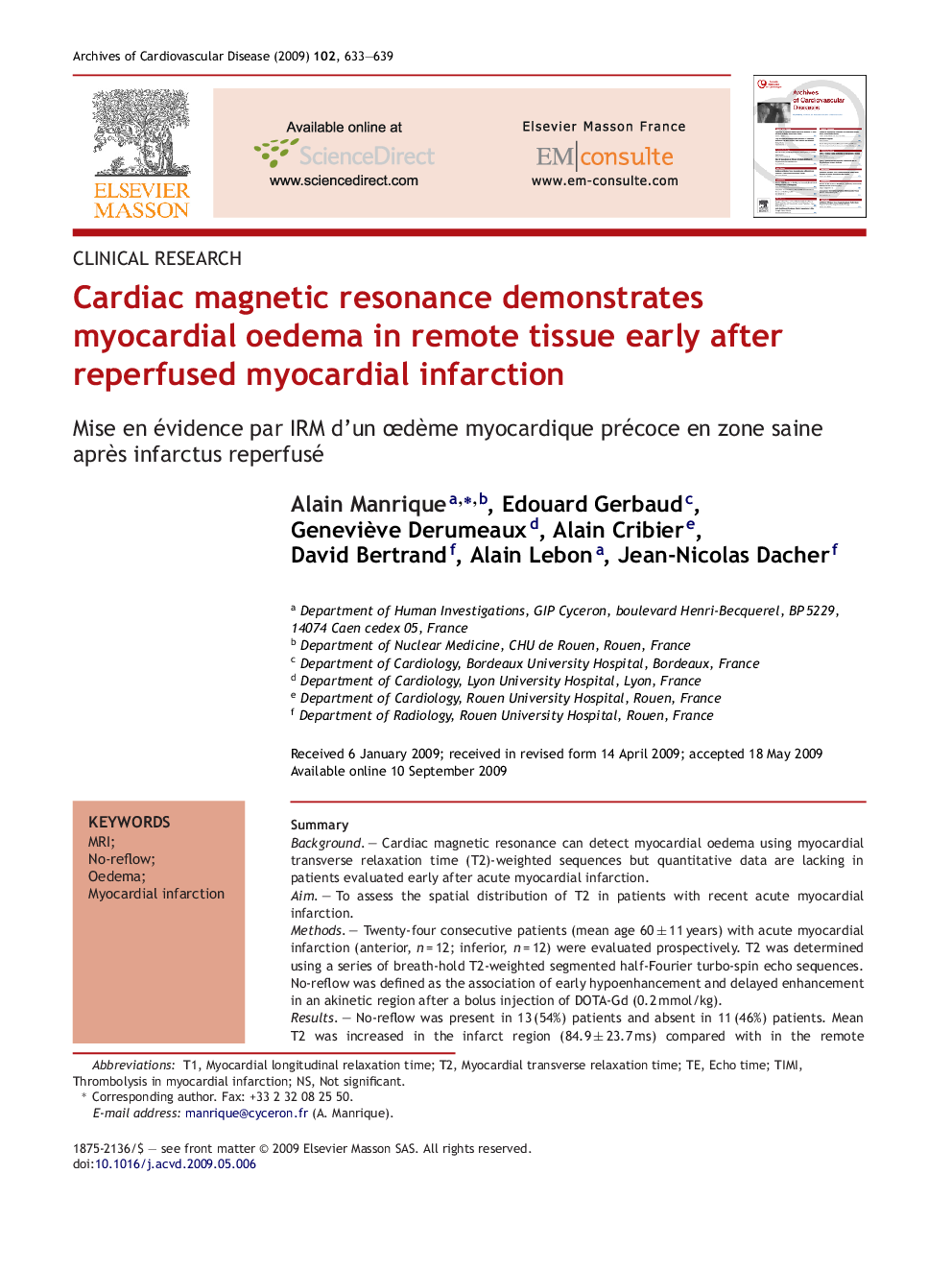| کد مقاله | کد نشریه | سال انتشار | مقاله انگلیسی | نسخه تمام متن |
|---|---|---|---|---|
| 2889564 | 1574401 | 2009 | 7 صفحه PDF | دانلود رایگان |

SummaryBackgroundCardiac magnetic resonance can detect myocardial oedema using myocardial transverse relaxation time (T2)-weighted sequences but quantitative data are lacking in patients evaluated early after acute myocardial infarction.AimTo assess the spatial distribution of T2 in patients with recent acute myocardial infarction.MethodsTwenty-four consecutive patients (mean age 60 ± 11 years) with acute myocardial infarction (anterior, n = 12; inferior, n = 12) were evaluated prospectively. T2 was determined using a series of breath-hold T2-weighted segmented half-Fourier turbo-spin echo sequences. No-reflow was defined as the association of early hypoenhancement and delayed enhancement in an akinetic region after a bolus injection of DOTA-Gd (0.2 mmol/kg).ResultsNo-reflow was present in 13 (54%) patients and absent in 11 (46%) patients. Mean T2 was increased in the infarct region (84.9 ± 23.7 ms) compared with in the remote myocardium (62.8 ± 10.3 ms, p = 0.0001) and in control subjects (55.7 ± 4.6 ms, p < 0.0001), but also in the remote myocardium compared with control subjects (p < 0.02). In patients with no-reflow, T2 was further increased within the infarcted subendocardium compared with in patients without no-reflow (97.9 ± 24.8 ms vs 76.3 ± 24.7 ms, p < 0.03). Peak troponin correlated with T2 (r = 0.47, p < 0.02) and was higher in patients with no-reflow (297.9 ± 249.7 μg/L) than in patients without no-reflow (42.4 ± 43.1 μg/L, p = 0.003).ConclusionT2 was lengthened in both infarcted and remote myocardium and was influenced by the occurrence of no-reflow.
RésuméButLe but de cette étude a été d’évaluer la distribution spatiale du temps de relaxation T2 à la phase aiguë de l’infarctus du myocarde.MéthodeVingt-qautre patients consécutifs (âge : 60 ± 11) hospitalisés pour un infarctus du myocarde (antérieur : 12, inférieur : 12) ont été prospectivement évalués. Le temps de relaxation T2 a été déterminé par résonance magnétique. Le no-reflow (NR) a été défini par l’association d’un hyposignal précoce et d’un hypersignal tardif dans les zones akinétiques après une injection de DOTA-Gd (0,2 mmol/kg).RésultatsUn NR a été constaté chez 13 patients (NR+ : 54 %) et absent chez 11 (NR− : 46 %). Le temps de relaxation T2 a été augmenté d’une part dans la zone de l’infarctus (84,9 ± 23,7 ms) comparé au myocarde normal (62,8 ± 10,3 ms, p = 0,0001) et comparé aux témoins (55,7 ± 4,6 ms, p < 0,0001) et, par ailleurs, dans le myocarde normal comparé aux témoins (p < 0,02). Chez les patients NR+, le temps de relaxation T2 a été augmenté dans le territoire sous-endocardique de la nécrose comparé aux patients NR− (97,9 ± 24,8 ms vs 76,3 ± 24,7 ms, p < 0,03). Le pic de troponine a été corrélé au temps de relaxation T2 (r = 0,47, p < 0,02) et a été plus élevé chez les patients NR+ (297,9 ± 149,7 μg/L) comparé aux patients NR- (42,4 ± 43,1 μg/L, p = 0,003).ConclusionDans cette étude, le temps de relaxation T2 était augmenté à la fois dans le territoire de nécrose et dans le territoire sain et était influencé par la survenue d’un phénomène de NR.
Journal: Archives of Cardiovascular Diseases - Volume 102, Issues 8–9, August–September 2009, Pages 633–639